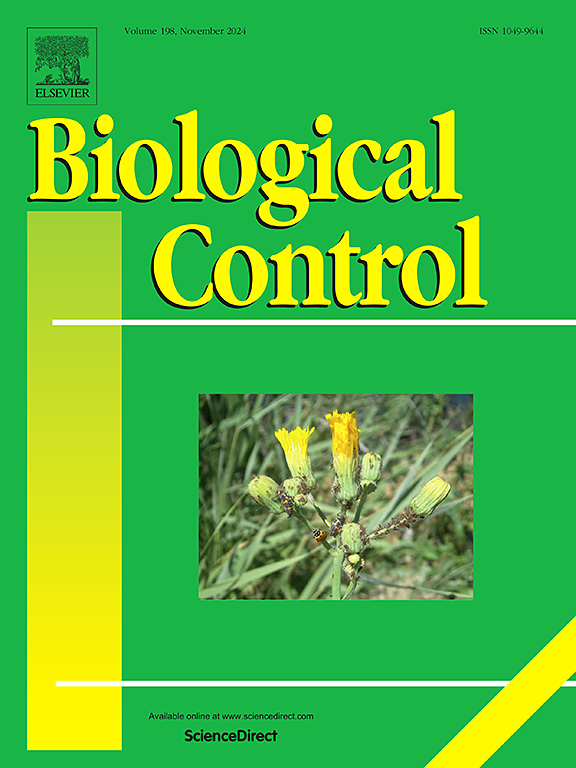Subsequent chemical and foraging ecology preferences of Theocolax elegans (Westwood) (Hymenoptera: Pteromalidae) reared on two alternate stored product host insects
IF 3.7
2区 农林科学
Q2 BIOTECHNOLOGY & APPLIED MICROBIOLOGY
引用次数: 0
Abstract
Theocolax elegans (Hymenoptera: Pteromalidae) is a potential postharvest biocontrol agent whose host range includes Sitophilus oryzae (Coleoptera: Curculionidae) and Rhyzopertha dominica (Coleoptera: Bostrichidae). Both host species are cosmopolitan and destructive pests of bulk wheat. In addition, either species could be used when mass rearing T. elegans. The Hopkins-Host Selection principle suggests the natal host environment (e.g., the habitat in which a wasp emerges from a pupa) may influence the semiochemicals an organism utilizes when foraging for oviposition sites. Thus, later efficacy may be impaired if important semiochemicals are lost from the foraging repertoire of T. elegans. In order to investigate the impact of natal host environment on the behavioral response of T. elegans to potential hosts, we reared T. elegans on either S. oryzae or R. dominica for multiple generations. We then evaluated the orientation and taxis of T. elegans to six treatments: S. oryzae, R. dominica, damaged grain + S. oryzae, damaged grain + R. dominica, damaged grain + insects from the natal environment, or an undamaged control. We found T. elegans reared on R. dominica most preferred damaged grain from R. dominica in a four-way olfactometer, which was 4.2-fold more often chosen than S. oryzae individuals alone. Treatments containing R. dominica were differentiated from others based on headspace volatiles while S. oryzae-infested grain generally overlapped with uninfested grain. Both rearing host and subsequent foraging host affected efficacy of T. elegans released in a pilot-scale elevator. Wasps appeared most effective in suppressing grain damage by 35–38 % when reared on R. dominica and foraging for R. dominica compared to S. oryzae-reared wasps that only reduced damage by 1–18 %. Sitophilus oryzae-reared wasps only effectively foraged on hosts up to 0.5 m, while R. dominica-reared wasps foraged successfully up to 4 m. Overall, we found that the natal host and chemical cues significantly affected taxis and foraging by T. elegans, suggesting that careful attention should be paid to the mass rearing procedure for this parasitoid.

膜翅目:叶蜂科(theoccolax elegans (Westwood))对两种代用储藏产品寄主昆虫的化学和觅食生态偏好
秀丽隐巢蜂(theoccolax elegans)是一种潜在的采后生物防治剂,其寄主范围包括米象蜂(鞘翅目:小蜂科)和多纹蜂(鞘翅目:Bostrichidae)。这两种寄主都是散装小麦的世界性和破坏性害虫。此外,这两个品种都可以用于线虫的大规模饲养。霍普金斯-寄主选择原则表明,出生寄主环境(例如,黄蜂从蛹中孵化的栖息地)可能会影响生物体在寻找产卵地点时使用的符号化学物质。因此,如果秀丽隐杆线虫在觅食过程中丢失了重要的化学物质,则后期的功效可能会受损。为了研究出生寄主环境对秀丽隐杆线虫对潜在寄主行为反应的影响,我们将秀丽隐杆线虫分别饲养在米曲霉或多米尼加r.m icica上多代。然后,我们评估了秀丽隐杆线虫对6种处理的定向和趋向性:米曲菌、稻曲菌、受损的谷物+稻曲菌、受损的谷物+稻曲菌、受损的谷物+来自出生环境的昆虫,或未受损的对照。结果表明,在四向嗅觉测试中,饲养的秀丽隐杆线虫最偏爱稻瘟菌的受损籽粒,其选择率是单独饲养稻瘟菌的4.2倍。稻瘟病菌侵染的籽粒与未侵染的籽粒重叠,稻瘟病菌处理与其他处理的顶空挥发物含量不同。饲养寄主和随后的觅食寄主均影响在中试升降机中释放秀丽隐杆线虫的效果。与仅以稻瘟病菌为饲料饲养的胡蜂相比,以稻瘟病菌为饲料饲养的胡蜂对粮食危害的抑制效果为35 - 38%,而以稻瘟病菌为饲料饲养的胡蜂对粮食危害的抑制效果为1 - 18%。米象蜂饲养的胡蜂只能在0.5米以内的寄主上有效觅食,而多明尼加饲养的胡蜂可以在4米以内成功觅食。综上所述,我们发现寄主和化学信号对线虫的趋向性和觅食行为有显著影响,提示线虫的大规模饲养过程应引起高度重视。
本文章由计算机程序翻译,如有差异,请以英文原文为准。
求助全文
约1分钟内获得全文
求助全文
来源期刊

Biological Control
生物-昆虫学
CiteScore
7.40
自引率
7.10%
发文量
220
审稿时长
63 days
期刊介绍:
Biological control is an environmentally sound and effective means of reducing or mitigating pests and pest effects through the use of natural enemies. The aim of Biological Control is to promote this science and technology through publication of original research articles and reviews of research and theory. The journal devotes a section to reports on biotechnologies dealing with the elucidation and use of genes or gene products for the enhancement of biological control agents.
The journal encompasses biological control of viral, microbial, nematode, insect, mite, weed, and vertebrate pests in agriculture, aquatic, forest, natural resource, stored product, and urban environments. Biological control of arthropod pests of human and domestic animals is also included. Ecological, molecular, and biotechnological approaches to the understanding of biological control are welcome.
 求助内容:
求助内容: 应助结果提醒方式:
应助结果提醒方式:


